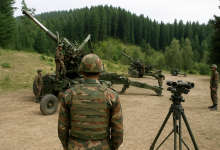Maratha Military Landscapes Added to UNESCO World Heritage List
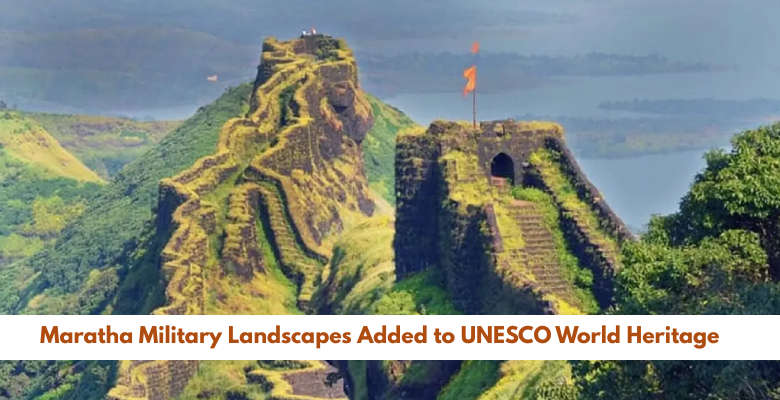
Maratha Military Landscapes—a name now written in history with golden letters—have officially been included in the prestigious UNESCO World Heritage List. This grand recognition is more than a title; it’s a celebration of India’s cultural strength, rich heritage, and the brilliant military architecture of the Maratha Empire.
On July 11, 2025, the UNESCO World Heritage Committee, during its 47th session in Paris, announced the addition of 12 iconic forts that reflect the courage, vision, and leadership of Chhatrapati Shivaji Maharaj. This decision marks a proud moment for every Indian, especially for the people of Maharashtra and Tamil Nadu.
Contents
A Proud Moment for India
Prime Minister Narendra Modi shared his excitement on social media platform X, saying:
“Every Indian has rejoiced with this honor. When we talk about the glorious Maratha Empire, we associate it with good governance, military strength, cultural pride, and an emphasis on social welfare. Their attitude of never bowing down to any injustice inspires us.”
He encouraged everyone to visit these majestic forts and explore the unmatched legacy of the Maratha rulers.
State Leaders Applaud the Recognition
Maharashtra’s Deputy Chief Minister Devendra Fadnavis called the inclusion a “proud and glorious moment.” He posted:
“The Maharashtra Government offers salutations to our beloved Chhatrapati Shivaji Maharaj! Heartiest congratulations to all the citizens and Shiv Bhakts of Maharashtra.”
Fadnavis also expressed gratitude toward PM Modi and his team for their unwavering support. He credited the Archaeological Survey of India, Ministry of Culture, and several key leaders for playing vital roles in pushing the nomination.
Another Deputy Chief Minister, Ajit Pawar, emphasized the historical and cultural importance of this achievement. He stated that this inclusion will bring global visibility to the bravery and wisdom of the Maratha warriors.
What is the Maratha Military Landscapes?
The Maratha Military Landscapes is a term given to a group of 12 strategically built forts across Maharashtra and Tamil Nadu. These forts demonstrate the genius military planning of the Maratha Empire between the 17th and 19th centuries. They were designed to protect the kingdom across various terrains—hills, coastal regions, and plains.
Here’s the complete list of the forts:
- Salher Fort
- Shivneri Fort
- Lohgad Fort
- Khanderi Fort
- Raigad Fort
- Rajgad Fort
- Pratapgad Fort
- Suvarnadurg Fort
- Panhala Fort
- Vijay Durg Fort
- Sindhudurg Fort
- Gingee Fort (Tamil Nadu)
Each of these forts carries centuries-old tales of strategy, sacrifice, and strength.
1. Salher Fort (Maharashtra)
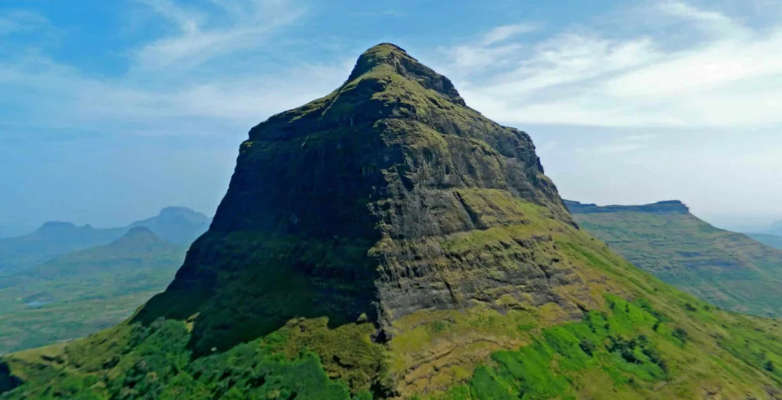
- How to Reach: Nearest town is Satana (about 70 km). From there, local buses or private vehicles can take you to the base village—Waghambe or Salherwadi.
- Famous For: Highest fort in Maharashtra; panoramic views and trekking.
- History: Site of the Battle of Salher (1672), a significant Maratha victory against the Mughals.
- Best Time to Visit: October to February (cool and pleasant for trekking).
2. Shivneri Fort (Maharashtra)

- How to Reach: Located near Junnar, around 90 km from Pune. Accessible by road.
- Famous For: Birthplace of Chhatrapati Shivaji Maharaj.
- History: A well-preserved fort with water cisterns, temples, and the exact room where Shivaji was born.
- Best Time to Visit: November to February.
3. Lohgad Fort (Maharashtra)
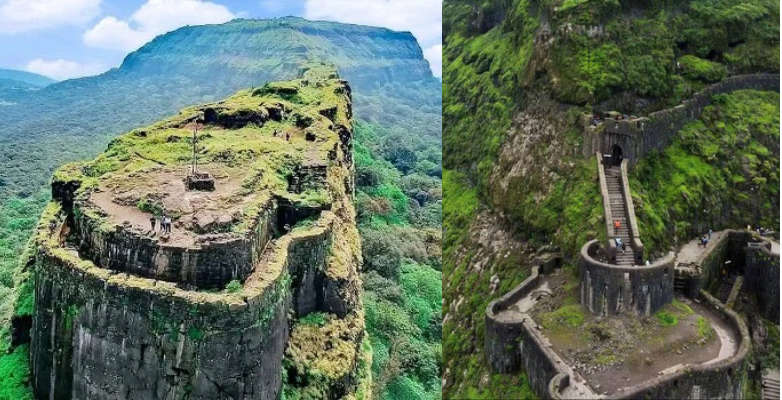
- How to Reach: Near Lonavala (12 km), accessible by road and rail. Local taxis available.
- Famous For: Easy trek, beautiful monsoon trails, and scenic views.
- History: Captured by Shivaji Maharaj in 1648; later used to store loot from Surat.
- Best Time to Visit: June to September (monsoon beauty), or November to February.
4. Khanderi Fort (Maharashtra)

- How to Reach: Located off the coast of Alibaug. Ferries operate from Thal beach (near Alibaug).
- Famous For: Sea fort with lighthouse; beautiful coastal view.
- History: Built by Shivaji Maharaj to control the Arabian Sea trade routes.
- Best Time to Visit: October to March.
5. Raigad Fort (Maharashtra)

- How to Reach: Located in Raigad district; base village is Pachad (130 km from Pune). Ropeway available.
- Famous For: Capital of the Maratha Empire under Shivaji Maharaj.
- History: Coronation site of Shivaji Maharaj; contains royal palace ruins and his Samadhi.
- Best Time to Visit: October to February.
6. Rajgad Fort (Maharashtra)

- How to Reach: About 40 km from Pune; reach via Pali or Gunjavane village.
- Famous For: Grand fort structure with multiple trekking routes.
- History: Capital before Raigad; Shivaji Maharaj spent over 20 years here.
- Best Time to Visit: October to February.
7. Pratapgad Fort (Maharashtra)
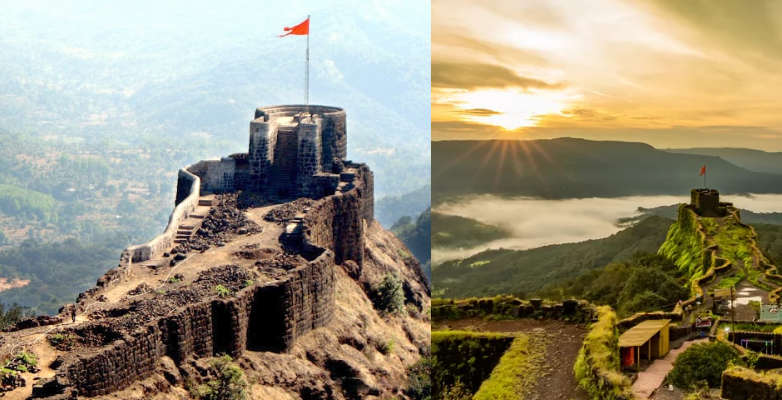
- How to Reach: Around 22 km from Mahabaleshwar; well-connected by road.
- Famous For: Battle of Pratapgad between Shivaji and Afzal Khan.
- History: Built in 1656; features memorials and Afzal Khan’s tomb.
- Best Time to Visit: October to March.
8. Suvarnadurg Fort (Maharashtra)

- How to Reach: Situated in the Arabian Sea near Harnai (Ratnagiri district); boats from Harnai port.
- Famous For: Sea fort built to protect the coastal Konkan region.
- History: Constructed by Shivaji to guard against Portuguese and British invasions.
- Best Time to Visit: November to February.
9. Panhala Fort (Maharashtra)

- How to Reach: Around 20 km from Kolhapur; buses and taxis available.
- Famous For: Largest fort in the Deccan region.
- History: Site of Shivaji’s strategic retreat from Siddi Johar; contains temples and granaries.
- Best Time to Visit: October to February.
10. Vijay Durg Fort (Maharashtra)

- How to Reach: Located near Devgad in Sindhudurg district; accessible by road.
- Famous For: Naval fort known for underwater defense walls.
- History: One of Shivaji’s strongest sea forts; never conquered by the British.
- Best Time to Visit: October to February.
11. Sindhudurg Fort (Maharashtra)

- How to Reach: Ferry from Malvan (550 km from Mumbai). Malvan is well-connected by road.
- Famous For: Fort built on an island with temple dedicated to Shivaji.
- History: Constructed in 1664; housed Maratha navy. Unique fingerprint of Shivaji is displayed here.
- Best Time to Visit: November to March.
12. Gingee Fort (Tamil Nadu)

- How to Reach: About 160 km from Chennai and 40 km from Villupuram. Accessible by road.
- Famous For: Called the “Troy of the East” for its massive structure.
- History: Temporarily under Maratha control; originally built by Cholas and later strengthened by Shivaji’s forces.
- Best Time to Visit: November to February.
Why This Recognition Matters
These forts are not just ancient structures—they’re living proof of how the Marathas turned architecture into a defensive tool. They used natural elements, strong stone walls, smart water storage, and elevated locations to ensure unbeatable protection.
According to UNESCO, the inclusion reflects India’s deep-rooted cultural traditions and historical continuity. It adds value to the preservation and promotion of Indian architecture and military innovation.
“New inscription on the @UNESCO #WorldHeritage List: Maratha Military Landscapes of India, #India.” — posted by UNESCO on X
Highlights of a Few Iconic Forts
Let’s look at some standout examples among the 12 forts:
- Raigad Fort: Once the capital of Shivaji Maharaj’s empire, it stands as a symbol of governance and royal administration.
- Pratapgad Fort: Located near Mahabaleshwar, this fort was the site of the historic battle between Shivaji Maharaj and Afzal Khan.
- Gingee Fort: A southern marvel in Tamil Nadu, it showcases how the Maratha presence spread far beyond Maharashtra.
Also read Biometric E Passport India 2025 – Features, Cities, Benefits & How To Apply
Historical Significance and Future Impact
This global recognition comes with added responsibility. Heritage experts believe it will lead to:
- Increased international and domestic tourism
- Boost in local economy and community pride
- Better conservation and restoration practices
- Educational value for students and history enthusiasts
The Maratha Military Landscapes now serve as ambassadors of India’s glorious past to the world.
Final Thoughts
With this recognition, India proudly steps forward as a guardian of not just history, but of inspiration. The courage of the Marathas and the vision of Chhatrapati Shivaji Maharaj now shine on the global stage—forever etched in the UNESCO World Heritage List.
If you ever dream of walking through the corridors of history, start with these 12 forts. The echoes of bravery still linger in their stone walls.
